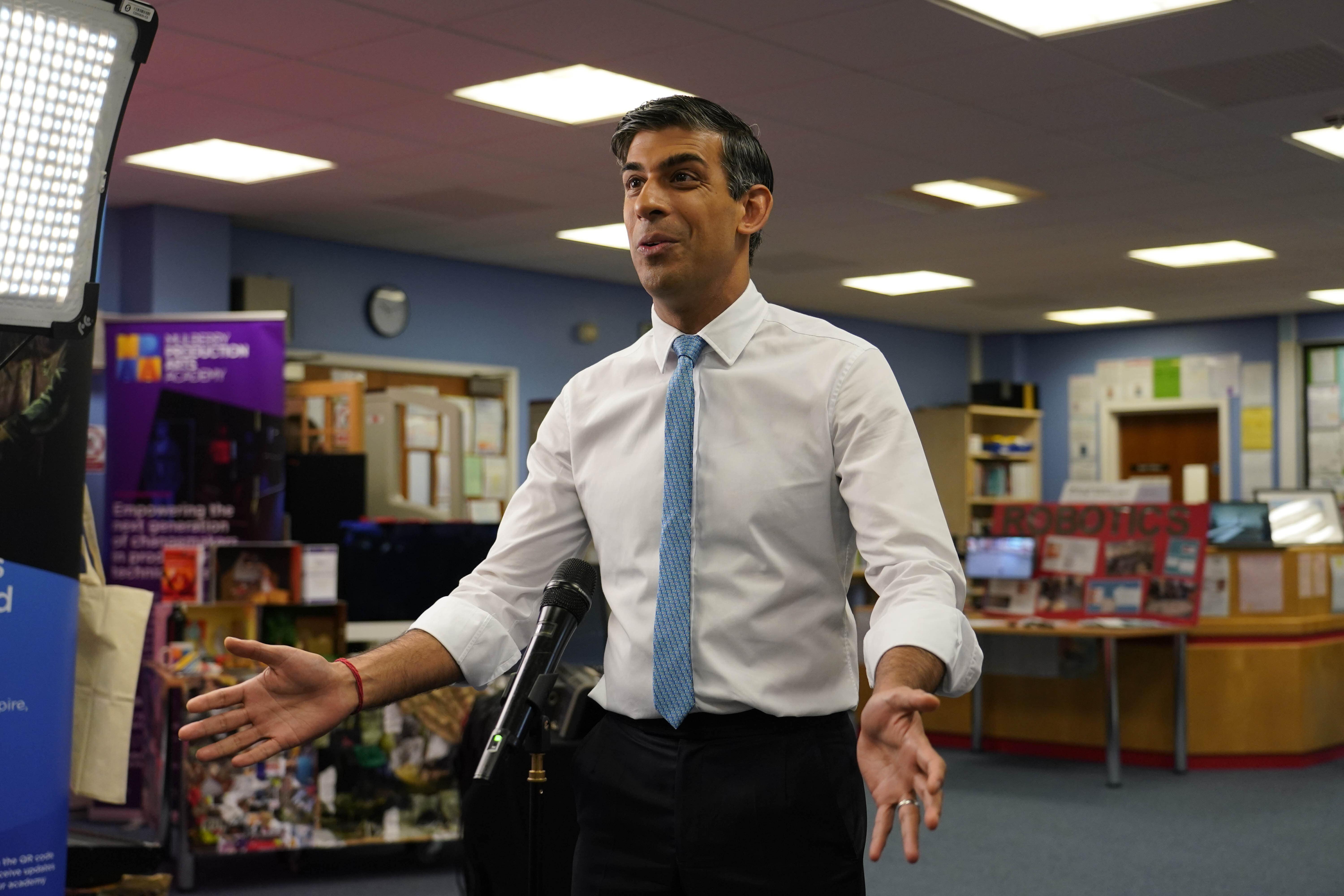Hundreds more schools could be hit by crumbling concrete row, Sunak acknowledges
Rishi Sunak said 95% of England’s 22,000 schools were unaffected, leaving open the possibility that hundreds could be impacted.

Your support helps us to tell the story
From reproductive rights to climate change to Big Tech, The Independent is on the ground when the story is developing. Whether it's investigating the financials of Elon Musk's pro-Trump PAC or producing our latest documentary, 'The A Word', which shines a light on the American women fighting for reproductive rights, we know how important it is to parse out the facts from the messaging.
At such a critical moment in US history, we need reporters on the ground. Your donation allows us to keep sending journalists to speak to both sides of the story.
The Independent is trusted by Americans across the entire political spectrum. And unlike many other quality news outlets, we choose not to lock Americans out of our reporting and analysis with paywalls. We believe quality journalism should be available to everyone, paid for by those who can afford it.
Your support makes all the difference.Hundreds more schools in England could be affected by crumbling concrete, Rishi Sunak acknowledged as he faced accusations he failed to fund a programme to replace ageing classrooms.
The Prime Minister insisted that 95% of England’s schools were unaffected, leaving open the possibility that more than a thousand could still be impacted by concerns over reinforced autoclaved aerated concrete (Raac).
Downing Street said the total number was expected to be in the hundreds rather than the thousands and the vast majority of schools would not be affected.
More than a hundred schools in England were told they could not fully open just days before the start of the autumn term because of safety fears over the use of Raac.
Pupils face being taught in temporary classrooms, on different sites or even forced into pandemic-style remote lessons.
Mr Sunak said: “New information came to light relatively recently and it’s important that once it had, that the Government acted on it as swiftly as possible.
“Of course I know the timing is frustrating, but I want to give people a sense of the scale of what we are grappling with here: there are around 22,000 schools in England and the important thing to know is that we expect that 95% of those schools won’t be impacted by this.”
If, as Mr Sunak said, 5% of schools are impacted, that would mean 1,100 are affected.
The Prime Minister’s official spokesman said : “I think the Prime Minister was providing reassurance to parents, pupils and schools that the vast majority – we believe more than 95% won’t be affected.”
He said Education Secretary Gillian Keegan had set out that “we expect the numbers to be in the hundreds, not thousands” but “while we are still waiting on schools to return their surveys and confirm their specific situations we can’t be more definitive”.
Ms Keegan told MPs later on Monday that a list of schools with confirmed reinforced autoclaved aerated concrete (Raac) will be published “this week”.
Meanwhile, a former top official at the Department for Education suggested Mr Sunak had declined a request for funding to rebuild more schools while he was chancellor.
Jonathan Slater, who was permanent secretary at the Department for Education (DfE) from May 2016 to August 2020, said the Treasury knew there was a “critical risk to life” if the schools programme was not funded.
Mr Slater said up to 400 schools a year need to be replaced, but the DfE got funding for 100 while he was the senior official, which was “frustrating”.
But when he left the department he said he was “optimistic” that a push for extra funding to build 200 a year would be successful.
He told BBC Radio 4’s Today programme: “The actual ask in the spending review of 2021 was to double the 100 to 200 – that’s what we thought was going to be practical at first instance.
“I thought we’d get it, but the actual decision that the chancellor took in 2021 was to halve the size of the programme.”
But Mr Sunak insisted that 50 schools a year was in line with what had taken place over the previous decade.
He told reporters Mr Slater’s attack on his record was “completely and utterly wrong”.
“Actually, one of the first things I did as chancellor, in my first spending review in 2020, was to announce a new 10-year school re-building programme for 500 schools.
“Now that equates to about 50 schools a year, that will be refurbished or rebuilt.
“If you look at what we have been doing over the previous decade, that’s completely in line with what we have always done.”
Shadow education secretary Bridget Phillipson said: “The defining image of 13 years of the Conservative-run education system will be children sat under steel girders to stop the roof falling in.”
She said Mr Sunak “bears huge culpability for his role in this debacle”, adding: “Ministers need to come clean about the number of schools affected, what they knew, and when they knew, about the risks posed by Raac so that parents can be reassured their children are safe at school.”
Liberal Democrat education spokeswoman Munira Wilson said: “This bombshell revelation shows the blame for this concrete crisis lies firmly at Rishi Sunak’s door.
“He slashed funding to repair crumbling classrooms when officials said it needed to be increased. Now children and parents across the country are paying the price for this disastrously short-sighted decision.”
Schools in Scotland, Wales and Northern Ireland are also being assessed for Raac.
The Scottish Government has said it is present in 35 schools, but that none poses an “immediate risk” to pupil safety.
The Welsh Government said two schools on Anglesey which had been due to open for the autumn term on Tuesday would be closed temporarily.